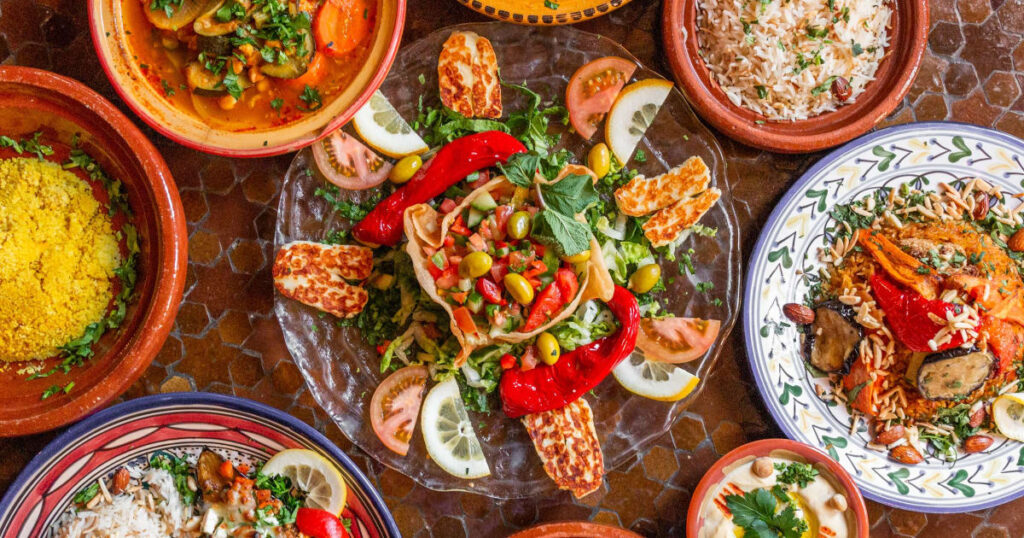Top 16 Traditional Persian Food Culinary Delights

Top 16 Traditional Persian Food Culinary Delights Embarking on a literary journey through the rich tapestry of Persian culture, one finds themselves in the enchanting realm of Iran, a land steeped in history and tradition. The mosaic of its culinary landscape mirrors the diversity of its people, each dish narrating a unique story and offering a delectable experience. Undoubtedly, much has been said and heard about the awe-inspiring landscapes and natural wonders of Iran. Equally captivating are the historical sites, integral to any Iranian expedition. For further exploration, please refer to the provided address. Let us now delve into the fascinating world of Iranian gastronomy, a realm as diverse as the cultures it encompasses. Persian cuisine, like the varied ethnicities that coexist within the country’s borders, is an intricate tapestry woven with nature’s bounty and cultural nuances. Rest assured, Persian cuisine has been put to the test and emerged victorious, as attested by countless foreign visitors who extol the virtues of its flavors, aromas, freshness, and culinary finesse. Each day in Iran promises a culinary adventure, a chance to tantalize the taste buds and immerse oneself in the richness of Persian culture. Savor the allure of Persian Food, a culinary masterpiece that transcends mere meals, inviting you to experience the essence of Iran’s cultural diversity. Let the tantalizing aromas and exquisite flavors of Persian Food transport you to the heart of Iran, where culinary artistry meets cultural celebration. The Pinnacle of Persian Food Palate: The 5 Exquisite Iranian Dishes Zereshk Polo An exemplary Iranian dish, frequently gracing important gatherings, is Zereshk Polo, often paired with succulent chicken. Crafted from the harmonious blend of barberry (Zereshk), saffron, and white rice, this dish not only delights the palate but also captivates with its visually stunning presentation. Zereshk Polo with chicken stands as a testament to Iran’s culinary prowess, garnering global acclaim for its surprising ease of preparation. Savor the exquisite blend of barberries, saffron rice, and tender chicken in Zereshk Polo – a culinary masterpiece that promises a journey of flavors like no other. Khoresht-e Ghormeh Sabzi A favorite among Iranians, Ghormeh Sabzi stew boasts a medley of aromatic vegetables, onions, Omani lemon, and a choice of red beans, sheep, veal, or lamb meat. The stew’s culinary magic lies in the extended cooking time, a characteristic shared with many Iranian dishes. Savored with plain or saffron-infused rice, Ghormeh Sabzi promises a flavorful and captivating experience for international connoisseurs. Indulge in the aromatic symphony of Ghormeh Sabzi, a Persian delight brimming with succulent meats and a dance of flavorful herbs, a true culinary enchantment. Khoresht-e Fesenjan Fesenjan stew, a Persian food that reigns supreme at significant gatherings and celebrations, is a gastronomic masterpiece. Crafted from ground walnuts, pomegranate paste, and chicken or meatballs, this stew hails from the northern regions of Iran, originally prepared with duck. While the cooking process demands patience at a low heat, mastering the technique ensures a home-cooked rendition as delightful as the authentic dish. Variations across Iran introduce subtle nuances, with some regions favoring a sour note by increasing the pomegranate syrup or adding a touch of sugar for sweetness. Chelo Kabab Koobideh Undoubtedly the most renowned Iranian dish or you say fantastic Persian food, Chelo Kabab (Kebab served with rice) has become synonymous with Iranian culinary expertise. Various kebabs, particularly Koobideh, enjoy immense popularity among locals and tourists alike. Koobideh, a ground meat blend seasoned with minced onion, salt, and pepper, takes center stage. Accompanied by grilled tomatoes and peppers, saffron rice, Dough (a yogurt-based drink), and fresh vegetables, this culinary masterpiece showcases the depth of Iranian gastronomy. Notably, Iranians occasionally opt for Kubideh with bread in lieu of rice. Persian Chicken Kebabs or Jujeh Kebab In a meat-loving culture, Iranian culinary traditions celebrate the preparation of grilled chicken, or Jujeh Kebab, a delectable dish enjoyed amid nature’s embrace. A pre-grilling ritual involves marinating chicken pieces in a mixture of grated onion, salt, and saffron, enhancing the dish’s flavors. Served alongside grilled tomatoes, saffron rice, and butter, this combination promises a mouthwatering experience. In the world of cuisine, Persian Food stands as a vibrant palette of flavors, offering a sensory voyage into the soul of Iran’s diverse culinary landscape. Beyond the Culinary Crown Jewels: Other Gastronomic Wonders in Iran Kuku Sabzi Kuku Sabzi, a versatile dish often served for dinner or as a snack, stands out for its simplicity and ease of preparation. Varieties abound across cities, with each locality infusing its distinctive touch. Comprising eggs and aromatic vegetables, Kuku Sabzi’s taste profile is elevated with the addition of chopped walnuts, barberries, or even beans. Beryani Isfahan’s renowned Beryani, a dish transcending regional boundaries due to its delightful taste, traditionally features mutton meat. Modern adaptations include chicken as a viable alternative. The dish, rich in history, incorporates sheep meat, onions, sheep lung, oil, turmeric, salt, and pepper, adorned with walnuts and basil. Served with vegetables, lime, and bread, Beryani represents a culinary journey through time. Khoresh Bademjan Eggplant lovers rejoice in the delightful Khoresh Bademjan, a savory stew combining meat, onions, spices, fried eggplants, and a generous portion of sour grapes. Typically presented with white or saffron-infused rice, this dish pays homage to Iranians’ affinity for eggplant. Dolmeh Dolmeh, encompassing various types such as grape leaf dolma (Dolmeh Barg Mo), tomato dolma, eggplant, and bell pepper, has permeated Iranian cuisine, transcending its regional origins in West and East Azerbaijan. Featuring a filling of ground meat, dolma vegetables, onions, and split beans, it stands as a testament to culinary diversity. Kale Pache A traditional dish prevalent in the Middle East and South Caucasus, Kale Pache captivates with its enduring popularity. A high-energy, fatty dish, it requires skilled preparation and is typically consumed in the morning. Caution is advised for those with specific health concerns, given its elevated fat content. Mosama Khoresht Alu (plum) Mosama stew, a popular Persian Food delight, showcases regional variations in its preparation. Chicken stew with plum
Interval Training Techniques, Regimens, & Fitness Benefits

Unlocking the Mysteries of Interval Training Interval training involves a series of repetitive exercise cycles, varying from minutes to seconds. Each interval requires exertion at a specific intensity for a defined duration or distance, known as the ‘work interval,’ followed by a low-intensity ‘recovery interval. Demystifying Interval Training Interval training is an ingeniously orchestrated method where the magnitude and duration of exertion phases and intervals of reprieve are astutely manipulated to orchestrate precise training responses. A holistic interval training regimen typically encompasses a series of brief and alternating interludes comprising both heightened and diminished intensity activities. Originally christened “Fartlek,” a term hailing from Sweden, denoting “speed play,” interval training amalgamates fleeting, vigorous bouts of exercise with leisurely, uncomplicated activities. The genesis of Fartlek training was a deliberate endeavor to outperform continuous training by intensifying workout rigors. However, interval training has since metamorphosed into a more structured and sophisticated modality for expeditiously advancing one’s fitness regimen. Unlike Fartlek training, which induces transient lactic acid accumulation, interval training artfully balances phases of activity with recuperation. The act of maintaining movement throughout the entire workout expedites lactic acid and waste product expulsion. Remarkably, interval training regimens are also meticulously tailored to individual athletes. Exercise physiologists and trainers meticulously measure specific activity durations commensurate with an athlete’s sport and current fitness level. Parameters such as intensity and duration are frequently gauged through anaerobic threshold (AT) testing, simultaneously monitoring an athlete’s blood lactate during intense exercise. Deconstructing Interval Training Mechanisms During the intense phases of activity, interval training cyclically engages the aerobic and anaerobic systems. The anaerobic system adeptly metabolizes glycogen stored in muscles for brief bursts of activity sans oxygen dependence. This endeavor results in lactic acid accumulation and the incurrence of an oxygen debt. Subsequently, the body convalesces as the heart and lungs synergize, supplying oxygen while concurrently dismantling the accrued lactic acid. The aerobic system seamlessly takes the reins, harnessing oxygen to convert stored carbohydrates into energy. Two Fundamental Categories of Interval Training While there exists an abundance of possibilities for configuring interval training routines, they can be distilled into two fundamental categories. The Fitness Interval Training This technique, ideal for novices and intermediate fitness enthusiasts, capitalizes on heightened intensity intervals (comprising 60% to 85% heart rate reserve) lasting approximately 2 to 5 minutes. These intense phases are followed by commensurate durations of lowered intensity. The Performance Interval Training More suited for highly-conditioned athletes, this regimen employs maximal intensity intervals (ranging from 85% to 100% heart rate reserve), typically spanning 2 to 15 minutes. Similar low-intensity intervals follow. If you take more interest in your health Building then go to: https://sitespot.us/health-wellness/ Diverse Interval Exercises The subsequent illustrations elucidate the adaptability of interval training routines across a plethora of sports and activities. By adroitly manipulating intensity and interval duration, specific training objectives can be realized. Skipping Rope: An economical and expeditious approach to bolster overall fitness, augmenting cardiovascular endurance, muscular robustness, endurance, equilibrium, agility, and calorie consumption. Brief 30-Second Sprints: Enhancing aerobic capacity and fitness expeditiously, offering parallel benefits to extended, leisurely cardiovascular workouts within half the time. Sprint and Velocity Training Drills: Delivering a confluence of swiftness and endurance, these drills accrue benefits across various sports. Commence only after three months of consistent athletic activity and once your fitness permits sustained running for 20-30 minutes. Explosive Exercise Training Regimens: A favored strategy among elite athletes in sports necessitating rapid bursts of maximal exertion, such as sprinting and leaping, for elevating power and robustness. Agility Drills: Enhancing coordination, celerity, potency, and sports prowess. These drills refine foot swiftness and fine-tune sports technique. Shuttle Runs: Standard drills enhancing agility and swiftness, catering to stop-and-start sports like basketball, soccer, hockey, and tennis. Stair Running: An advanced program fostering rapidity, potency, and cardiovascular fitness. An invaluable augmentation to agility training, distinguished by celerity, foot speed, and a superb sprint regimen. Plyometric Jumping Exercises: Leveraged by numerous athletes and trainers to nurture athletic prowess, comprising strength, swiftness, coordination, and agility, thus amplifying sports performance. Tuck Jumps: Simple drills that cultivate agility and dynamic potency, elevating an athlete’s vertical leap. These drills fine-tune proficiency in vertical, high, box, and long jumps. The Efficacy of Interval Exercise Unveiled Interval training is a versatile tool that caters to individuals at various junctures of their fitness voyage, spanning neophytes, intermediates, and seasoned athletes. It affords an intensified exposure to rigorous training sans the burden of excessive fatigue. Repetitious intensity compels the body to adapt, engendering manifold advantages: The genesis of novel capillaries augments the delivery of oxygen to fortify muscles, encompassing the cardiac muscle. A confluence of an enhanced cardiovascular system with muscles that withstand lactic acid buildup perceptibly amplifies athletic prowess and overall well-being. Reduced incidence of injuries linked to prolonged, repetitive exercise routines, owing to the absence of overtraining or burnout. Elevated aerobic potential and fitness levels across the spectrum. An invaluable ally for those venturing into novel exercises or activities, facilitating a gradual transition to sustained activity that is both gratifying and efficacious, while averting premature exhaustion. Caveats and Safety Protocols in That Training Interval training constitutes a superlative exercise modality, yet the primary caveat relates to the proclivity of individuals to overexert themselves due to the rigorous nature of the exercises, culminating in muscular and joint discomfort, overtraining, and an augmented susceptibility to injury. Here are several precautions demanding your consideration: Establish a pragmatic training objective that aligns with your prevailing fitness status. Preamble your interval sessions with a secure warm-up routine. Initiate gradually and progress toward protracted intervals to optimize outcomes. Uphold a steady yet demanding tempo throughout the interval. Increment repetitions incrementally over time. Curtail your heart rate to 100-110 beats per Conclusion this type of training, a meticulously structured fitness regimen, consists of recurring exercise cycles, varying from seconds to minutes. It entails exerting oneself at a specific intensity for a defined time or distance (termed the ‘work interval’), followed by a
